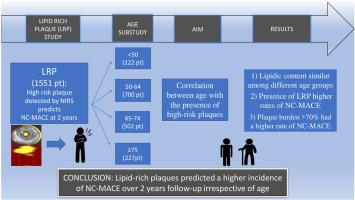Atherosclerosis ( IF 5.3 ) Pub Date : 2021-08-14 , DOI: 10.1016/j.atherosclerosis.2021.08.022 Gabriele Bambagioni 1 , Carlo Di Mario 1 , Rebecca Torguson 2 , Pierluigi Demola 1 , Ziad Ali 3 , Varinder Singh 4 , William Skinner 5 , Andre Artis 6 , Tim Ten Cate 7 , Cheng Zhang 8 , Hector M Garcia-Garcia 8 , Gheorghe Doros 8 , Gary S Mintz 8 , Ron Waksman 8

|
Background and aims
In this Lipid Rich Plaque (LRP) sub-study, 1551 patients undergoing coronary angiography for acute coronary syndromes or stable angina were examined with near-infrared spectroscopy (NIRS) and intravascular ultrasound (IVUS). We aimed to assess the correlation of patient age with the presence of high-risk plaques, defined as maximum 4-mm Lipid Core Burden Index (maxLCBI4mm) >400 and plaque burden >70%, and 2-year incidence of non-culprit major adverse cardiovascular events (NC-MACE).
Methods
The study population was divided into four groups according to age: <50 years (122), 50–64 years (700), 65–74 years (502), and ≥75 years (227). The primary outcome was NC-MACE from index procedure to event or the end of the study. Cox regression and mixed-effects Cox regression models were used to assess the effect of age on the association between LCBI and NC-MACE at the patient and plaque levels.
Results
Average maxLCBI4mm and percentage of patients with at least one segment with maxLCBI4mm > 400 were similar across the four age groups at both the patient and coronary segment levels. Having at least one segment with maxLCBI4mm > 400 was strongly associated with NC-MACE, and that association did not differ significantly across age subgroups. Although less common (prevalence of 0.8%–1.3%), a similar trend toward greater NC-MACE rates was seen in patients with plaque burden >70% at the maximum LCBI site across age subgroups.
Conclusions
Lipid-rich plaques were as frequent in older as in younger patients and predicted a higher incidence of NC-MACE over 2-year follow-up irrespective of age.
中文翻译:

近红外光谱检测到的富脂斑块可预测冠状动脉事件,与年龄无关:富脂斑块子研究
背景和目标
在这项富含脂质斑块 (LRP) 的子研究中,1551 名因急性冠状动脉综合征或稳定型心绞痛接受冠状动脉造影的患者接受了近红外光谱 (NIRS) 和血管内超声 (IVUS) 的检查。我们旨在评估患者年龄与高风险斑块存在的相关性,定义为最大 4 毫米脂质核心负荷指数 (maxLCBI 4mm ) >400 和斑块负荷 >70%,以及 2 年非罪魁祸首发生率主要不良心血管事件(NC-MACE)。
方法
研究人群根据年龄分为四组:<50 岁 (122)、50-64 岁 (700)、65-74 岁 (502) 和≥75 岁 (227)。主要结果是从指标程序到事件或研究结束的 NC-MACE。Cox 回归和混合效应 Cox 回归模型用于评估年龄对 LCBI 和 NC-MACE 在患者和斑块水平之间关联的影响。
结果
四个年龄组的平均 maxLCBI 4mm和至少一个节段 maxLCBI 4mm > 400的患者百分比在患者和冠状动脉节段水平上相似。至少有一个 maxLCBI 4mm > 400 的节段与NC-MACE 密切相关,并且这种关联在年龄亚组之间没有显着差异。尽管不太常见(患病率为 0.8%–1.3%),但在各年龄亚组最大 LCBI 部位斑块负荷 >70% 的患者中,也看到了类似的 NC-MACE 发生率更高的趋势。
结论
富脂斑块在老年患者和年轻患者中的发生率一样高,并且无论年龄如何,都预测 2 年随访期间 NC-MACE 的发生率更高。



























 京公网安备 11010802027423号
京公网安备 11010802027423号